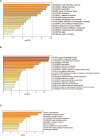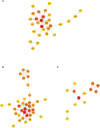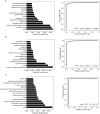Serum Antigenome Profiling Reveals Diagnostic Models for Rheumatoid Arthritis
- PMID: 35514972
- PMCID: PMC9065411
- DOI: 10.3389/fimmu.2022.884462
Serum Antigenome Profiling Reveals Diagnostic Models for Rheumatoid Arthritis
Abstract
Objective: The study aimed to investigate the serum antigenomic profiling in rheumatoid arthritis (RA) and determine potential diagnostic biomarkers using label-free proteomic technology implemented with machine-learning algorithm.
Method: Serum antigens were captured from a cohort consisting of 60 RA patients (45 ACPA-positive RA patients and 15 ACPA-negative RA patients), together with sex- and age-matched 30 osteoarthritis (OA) patients and 30 healthy controls. Liquid chromatography-tandem mass spectrometry (LC-MS/MS) was then performed. The significantly upregulated and downregulated proteins with fold change > 1.5 (p < 0.05) were selected. Based on these differentially expressed proteins (DEPs), a machine learning model was trained and validated to classify RA, ACPA-positive RA, and ACPA-negative RA.
Results: We identified 62, 71, and 49 DEPs in RA, ACPA-positive RA, and ACPA-negative RA, respectively, as compared to OA and healthy controls. Typical pathway enrichment and protein-protein interaction networks were shown among these DEPs. Three panels were constructed to classify RA, ACPA-positive RA, and ACPA-negative RA using random forest models algorithm based on the molecular signature of DEPs, whose area under curve (AUC) were calculated as 0.9949 (95% CI = 0.9792-1), 0.9913 (95% CI = 0.9653-1), and 1.0 (95% CI = 1-1).
Conclusion: This study illustrated the serum auto-antigen profiling of RA. Among them, three panels of antigens were identified as diagnostic biomarkers to classify RA, ACPA-positive, and ACPA-negative RA patients.
Keywords: antigenome; biomarkers; mass spectrometry; random forest; rheumatoid arthritis.
Copyright © 2022 Han, Hou, Zheng, Cao, Shi, Zhang, Ye, Pan, Liu, Li, Hu and Li.
Conflict of interest statement
The authors declare that the research was conducted in the absence of any commercial or financial relationships that could be construed as a potential conflict of interest.
Figures






Similar articles
-
Serum proteomic networks associate with pre-clinical rheumatoid arthritis autoantibodies and longitudinal outcomes.Front Immunol. 2022 Sep 8;13:958145. doi: 10.3389/fimmu.2022.958145. eCollection 2022. Front Immunol. 2022. PMID: 36159862 Free PMC article.
-
Identification and Validation of SAA4 as a Rheumatoid Arthritis Prescreening Marker by Liquid Chromatography Tandem-mass Spectrometry.Molecules. 2017 May 14;22(5):805. doi: 10.3390/molecules22050805. Molecules. 2017. PMID: 28505104 Free PMC article.
-
Urinary proteome profile predictive of disease activity in rheumatoid arthritis.J Proteome Res. 2014 Nov 7;13(11):5206-17. doi: 10.1021/pr500467d. Epub 2014 Sep 15. J Proteome Res. 2014. PMID: 25222917
-
ACPA-negative rheumatoid arthritis: From immune mechanisms to clinical translation.EBioMedicine. 2022 Sep;83:104233. doi: 10.1016/j.ebiom.2022.104233. Epub 2022 Aug 23. EBioMedicine. 2022. PMID: 36027873 Free PMC article. Review.
-
Opportunities and challenges for the discovery and validation of proteomic biomarkers for common arthritic diseases.Biomark Med. 2017 Oct;11(10):877-892. doi: 10.2217/bmm-2016-0374. Epub 2017 Oct 4. Biomark Med. 2017. PMID: 28976778 Review.
Cited by
-
Advancing precision rheumatology: applications of machine learning for rheumatoid arthritis management.Front Immunol. 2024 Jun 10;15:1409555. doi: 10.3389/fimmu.2024.1409555. eCollection 2024. Front Immunol. 2024. PMID: 38915408 Free PMC article. Review.
-
Current application, possibilities, and challenges of artificial intelligence in the management of rheumatoid arthritis, axial spondyloarthritis, and psoriatic arthritis.Ther Adv Musculoskelet Dis. 2025 Jun 21;17:1759720X251343579. doi: 10.1177/1759720X251343579. eCollection 2025. Ther Adv Musculoskelet Dis. 2025. PMID: 40547599 Free PMC article. Review.
-
AI-Assisted Plasmonic Diagnostics Platform for Osteoarthritis and Rheumatoid Arthritis With Biomarker Quantification Using Mathematical Models.Small. 2025 May;21(18):e2500264. doi: 10.1002/smll.202500264. Epub 2025 Mar 30. Small. 2025. PMID: 40159800 Free PMC article.
References
Publication types
MeSH terms
Substances
LinkOut - more resources
Full Text Sources
Other Literature Sources
Medical

